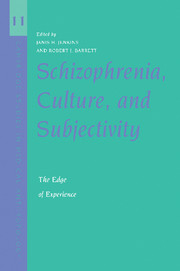Book contents
- Frontmatter
- Contents
- Contributors
- Preface
- Acknowledgments
- Schizophrenia, Culture, and Subjectivity
- Introduction
- Part 1 Culture, Self, and Experience
- 1 Schizophrenia as a Paradigm Case for Understanding Fundamental Human Processes
- 2 Interrogating the Meaning of “Culture” in the WHO International Studies of Schizophrenia
- 3 Kurt Schneider in Borneo: Do First Rank Symptoms Apply to the Iban?
- 4 Living Through a Staggering World: The Play of Signifiers in Early Psychosis in South India
- 5 In and Out of Culture: Ethnographic Means to Interpreting Schizophrenia
- Part 2 Four Approaches for Investigating the Experience of Schizophrenia
- Part 3 Subjectivity and Emotion
- Index
- References
5 - In and Out of Culture: Ethnographic Means to Interpreting Schizophrenia
Published online by Cambridge University Press: 25 January 2010
- Frontmatter
- Contents
- Contributors
- Preface
- Acknowledgments
- Schizophrenia, Culture, and Subjectivity
- Introduction
- Part 1 Culture, Self, and Experience
- 1 Schizophrenia as a Paradigm Case for Understanding Fundamental Human Processes
- 2 Interrogating the Meaning of “Culture” in the WHO International Studies of Schizophrenia
- 3 Kurt Schneider in Borneo: Do First Rank Symptoms Apply to the Iban?
- 4 Living Through a Staggering World: The Play of Signifiers in Early Psychosis in South India
- 5 In and Out of Culture: Ethnographic Means to Interpreting Schizophrenia
- Part 2 Four Approaches for Investigating the Experience of Schizophrenia
- Part 3 Subjectivity and Emotion
- Index
- References
Summary
Introduction
Schizophrenia is often represented as an ineffable phenomenon, the meaning of which is almost impossible to grasp. Historically, it has epitomized an inaccessible subjectivity and a point of failed intersubjectivity (see Barham 1993). For some commentators it is the “essence of incomprehensibility itself” (Sass 1992:19). People diagnosed with it have been deemed to be “ununderstandable” (Jaspers 1963: 577ff), to be “outside the human community” (Rümke 1990:336), to have repudiated the social world, or to have negated the “human role” (Shulman 1968:190). Such characterizations are encoded in clinical formulations of schizophrenia and are implicit in all of those institutional processes by which a person is identified as (and comes to know themselves as) a “schizophrenic.” Such fraught understanding was also a feature of peoples' accounts of their experiences of schizophrenia elicited as part of an ethnographic research project. Both clinically and experientially, schizophrenia can be apprehended as lying outside of culture.
This chapter explores such resonances in the relationship between culture and schizophrenia. Classic clinical accounts suggest that assumptions about culture and its transgression are encoded in the very concept of schizophrenia. These assumptions are made available to patients through their own diagnosis. Patients' and clinicians' understandings of what constitutes “culture,” and what it means to be outside of it, are shown to be remarkably similar.
But there is also a significant disjuncture between these formulations and the “culture” that ethnography identifies as the vehicle and expression of peoples' everyday lives.
- Type
- Chapter
- Information
- Schizophrenia, Culture, and SubjectivityThe Edge of Experience, pp. 146 - 164Publisher: Cambridge University PressPrint publication year: 2003
References
- 3
- Cited by



